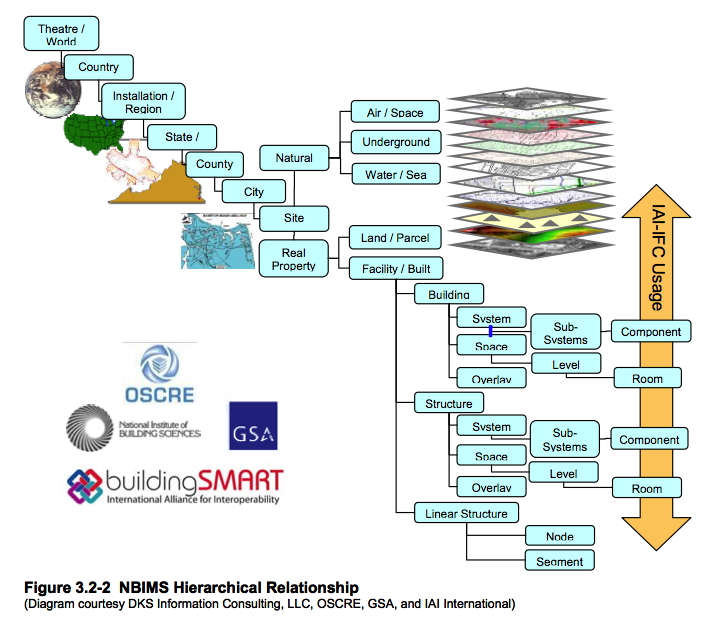- From: Ronald P. Reck <rreck@rrecktek.com>
- Date: Mon, 30 Jan 2012 10:23:36 -0500
- To: W3C GLD WG <public-gld-wg@w3.org>
- Message-ID: <4F26B5F8.4030908@rrecktek.com>
My friend Deborah and I have discussed this and similar issues for several years now, and this is what she replied when I asked her. She is willing to talk about it, if anyone would like to find out more. -------- Original Message -------- Subject: RE: ISSUE-23: How to relate a person to a building/room? [People] Date: Mon, 30 Jan 2012 10:13:18 -0500 From: MacPherson, Deborah <dmacpherson@CANNONDESIGN.COM> To: rreck@rrecktek.com <rreck@rrecktek.com> Hi Ron To represent buildings - OmniClass Tables 11 and 12 (http://www.omniclass.org) is facility types by function and by form, Table 11 (function) is currently being updated. Attached is a mapping between existing Table 11 with International Code Council occupancy classes. There is also OGC CityGML http://schemas.opengis.net/citygml/. Even though the facility types are not very good, CityGML is still a useful overall schema that includes geometry. The Open Standards for Real Estate Consortium (OSCRE) has a terrific new proposal for Real Property Unique ID's (RPUID) like vehicle identification numbers, need a non-profit org like ICANN to maintain a registry. RE: VCard - the IETF and SmartGrid people are working on some interesting ideas to identify building capabilities at a glance... Moving inside the building: For rooms - OmniClass Tables 13 and 14 - spaces by function and spaces by form. Table 13 was just approved by the US National Building Information Modeling Standard (NBIMS). Table 14 is in development and is an ideal link to GIS. To relate a person to the building/room - ideal would be pulling a subset from NIEM with extensive definitions and relations about people, and the attached spreadsheet. RE: the Buildings and Rooms Vocabulary [1] would in fact be capable to do this, however the namespace is sub-optimal, in terms of stability. I think the classes are all wrong and need to be more like the attached "NBIMHierarchicalRelationship" where a room is part of a floor rather than vice-versa. Also "zone" is more a appropriate concept than floor section. "Desk" might not be as useful as "Seat" if tracking computers and workers. "Occupant" is the right concept for a person - however - there more parameters such as typical operating hours, whether people live there etc. are needed to be useful. Finally "Facility" is the preferred term because building is both a noun and a verb and has all kinds of other connotations in other domains. Regards, Deb DEBORAH MACPHERSON, CSI CCS, AIA Specifications and Research Cannon Design 1100 Wilson Boulevard, Suite 2900 Arlington, Virginia 22209 Direct Line 703 907 2353 4 Digit Dial 6353 dmacpherson@cannondesign.com cannondesign.com Please consider the environment before printing this email. -------- Original Message -------- Subject: ISSUE-23: How to relate a person to a building/room? [People] Resent-Date: Sun, 29 Jan 2012 11:07:29 +0000 Resent-From: public-gld-wg@w3.org Date: Sun, 29 Jan 2012 11:07:24 +0000 From: Government Linked Data Working Group Issue Tracker <sysbot+tracker@w3.org> Reply-To: Government Linked Data Working Group WG <public-gld-wg@w3.org> To: public-gld-wg@w3.org ISSUE-23: How to relate a person to a building/room? [People] http://www.w3.org/2011/gld/track/issues/23 Raised by: Michael Hausenblas On product: People There are really two issues here, namely how to represent buildings and rooms and how to relate a person to the building/room. It seems that the Buildings and Rooms Vocabulary [1] would in fact be capable to do this, however the namespace is sub-optimal, in terms of stability. [1] http://vocab.deri.ie/rooms#
Attachments
- image/jpeg attachment: NBIMHierarchicalRelationship.jpg

- application/vnd.ms-excel attachment: FacilityTypeTemplate.xls
Received on Monday, 30 January 2012 15:23:52 UTC